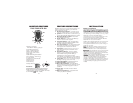
• Check fuse for lighter socket; replace if
necessary.
• Make sure lighter socket is clean.
PROBLEM: Unit alarms when vehicle hits
bumps.
• Make sure batteries are seated properly.
• Make sure that the battery door is fully closed.
• Make sure battery contacts are clean.
• Check for loose lighter socket; tighten and
clean.
• Check connections at both ends of power
cord. Substitute another cord to determine if
cord is defective. Return defective cord to
the factory.
PROBLEM: Audio alerts are not loud
enough.
• Cancel Auto Quiet Mode or City Mode.
• Check audio level setting (see page 8 ).
PROBLEM: Low Battery Life.
• Recharge the batteries using the home
charger. (Optional with the 1788R)
• One or more of the batteries may be
defective.
• See the battery life tips on page 7.
If difficulties occur which cannot be solved by
information in this Troubleshooting Guide, please
call Whistler Customer Service at 1-800-531-0004
or visit our FAQ page at
www.
whistlergroup.com/faq-detectors.asp,
before returning your unit for service.
PROBLEM: Unit turns itself off
• See battery saver feature on page 11
TROUBLESHOOTING
Care And Maintenance
During the summer months, avoid prolonged
exposure to direct sunlight by removing your unit
from the dash when your vehicle is parked for an
extended period of time. Do not spray water,
cleaners, or polishes directly onto the unit. The
spray may penetrate through the openings and
damage the unit. Also, do not use any abrasive
cleaners on the unit’s exterior.
As with all battery operated devices remove the
batteries when this unit will not be used for an
extended period of time. Damage caused by
leaky or improperly charged batteries are not
covered under warranty. Check with the battery
manufacturer about the specific battery warranty.
ARE DETECTORS LEGAL?
In Most States YES!
Laser-Radar detectors are legal in every state
(with the exception of Virginia and Washington,
D.C., which have local regulations restricting the
use of radar receivers in any vehicle) when used
in automobiles or light trucks (under 10,000 lbs.).
Concerning trucks over 10,000 lbs., the Federal
Highway Administration (FHWA) issued a
regulation, effective January, 1994 which prohibits
radar and laser detector use in these types of
vehicles nationally. Prior to the FHWA regulation,
laws existed in the state of New York restricting
the use of radar detectors in trucks over 18,000
lbs. and in Illinois in trucks over 26,000 lbs.
CARE AND MAINTENANCE
FCC ID : HSXWH15
This device complies with part 15 of the FCC
Rules. Operation is subject to the following two
conditions:
(1) This device many not cause harmful
interference, and
(2) this device must accept any interference
received, including interference that may cause
undesired operation.
Important: FCC requirements state that
changes or modifications not expressly approved
by Whistler could void the user’s authority to
operate the equipment.
SPEED MONITORING
Radar Facts
A radar gun operates by transmitting radio
waves at certain frequencies which reflect off
objects and are picked up by the radar gun’s
receiving section. When a radar beam reflects
off a moving target, a measurable frequency shift
occurs. The radar unit converts this shift into miles
per hour to determine your vehicle’s speed.
Currently, the FCC (Federal Communications
Commission) permits operation of traffic radar
guns at X Band (10.500 - 10.550 GHz), K Band
(24.050 - 24.250 GHz), and Ka Band (33.400 -
36.000 GHz).
Note: A radar detector will not alarm if an offi-
cer is not transmitting on any one of the above
radar bands.
POP™ Mode
POP
™
Mode is a feature on some newer radar
guns operating on K and Ka bands. When the
gun is in POP
™
Mode and activated, a brief burst
of energy, less that 1/15 of a second, is transmit-
ted and the vehicle’s speed is quickly acquired. A
detector without POP
™
Mode detection capabili-
ty cannot respond to this brief transmission.
FCC INFORMATION
17
18
19












